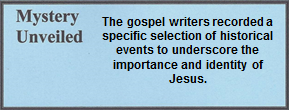02.02.11 Gospels. The word gospel is from the Greek term euaggelion (2098),[1] meaning good news or joyful news,[2] but it is good news for those who accept it and bad news for those who reject it. The English word is from the Anglo-Saxon term meaning God-spell, or God story.[3] The term Gospels refers to the four New Testament books of Matthew, Mark, Luke, and John.[4] These books paint a portrait of Jesus as the Messiah of the Jewish people and all humanity. The first three are also known as the “synoptic gospels,” because they “see together” a common message. Each writer presented his account from his unique perspective. Only Luke had any intention of writing a chronological account. However, the chronology of events was considered to be a relatively minor point compared to the words and works of Jesus and His ultimate goal.[5] These four books were written for the following reasons:
- The Jewish Oral Tradition accurately conveyed the Oral Law from generation to generation. The Gentiles, however, did not have that tradition, and therefore, needed written materials.
- Although written separately, each clarifies and supplements the other books. Mark wrote his book with an emphasis on historical events, even if these placed a negative light on the disciples. Since he was writing to Gentiles, he explains many Jewish customs. Luke wrote to a Greek audience to proclaim that Jesus was the Savior of all humanity, whereas John is a theological text that proclaims Jesus is the divine Son of God, and hence, he used numerous “I am” statements.
- The Jewishness of Jesus is portrayed differently in each text so that, when all are considered, a broad view of Him is presented.[6] Note the following characteristics:
- Matthew: Jesus is the coming Messiah who fulfilled prophecies.[7] Matthew wrote specifically to the Jewish people for whom the Davidic line was important, and furthermore, he wrote in five distinct teaching blocks.[8] Some scholars debate whether he wrote in Hebrew (or Biblical Hebrew) or in a new slightly modified Jewish style known as Mishnaic Hebrew.[9]
- Mark: Jesus is the suffering Servant. Mark wrote to the Romans who were more interested in what Jesus did rather than what He taught. Therefore, words such as “immediately” appear more than forty times. He recorded Peter’s preaching without chronological order. Scholars almost universally agree that the book was written in geographical sections.[10]
- Luke: Jesus is the Savior of all humanity. Luke wrote to the Greeks who idealized the perfect man and were also interested in historical accuracy. Therefore, he begins his gospel record with the comment concerning his investigation and chronological accuracy. He also mentioned the humanity of Jesus, such as being tired or thirsty, which is reflective on his professional life as a physician,[11] which added respect to his work.
- John: Jesus is the divine Son of God. John wrote to the church at large and emphasized the life of Jesus theologically – with a greater focus on what He taught than what He did – the opposite of Mark. John also made use of the “perfect number” seven,[12] mentioning seven “I am” statements,[13] seven discourses,[14] and seven signs or miracles.[15]

Three other significant points of study are that,
- The gospels repeatedly attest to the historical reliability of the life of the Jews and
- Each gospel was written to address a specific need for some specific people – also known as contextualization.
- Finally, the gospels are not letters, commonly known as “epistles,” but are a unique genre of literature. Essentially, they are accounts or reports of the good news of Christ Jesus, or, as one scholar said, they are a kind of informative advertisement.[16]
It is generally agreed that all these were written before A.D. 70, as evidenced by a constant reference to the temple and its functions. Obviously, these references would be absent if written after its destruction. Matthew and Mark, writers with some idealistic tendencies, would certainly have recorded destruction and its profound influence upon the Church and Jewish people. Jesus’ teachings, miracles, and resurrection were very important to Mark who wrote his gospel during Nero’s persecution of Christians in Rome. The Roman Gentiles had a theological difficulty with a deity who was crucified, but Mark addressed this issue.
Luke was not a disciple of Jesus but came to the faith through the teachings of the Apostle Paul. As a physician, he was a highly educated and observant man who carefully researched various accounts before writing his gospel and the book of Acts. His literary style is of the finest Greek, which is a reflection of his cultural and educational background. However, there is growing evidence that causes some scholars to argue that some words of Jesus may have been recorded in His lifetime.[17] This is not to say that the gospels were written at that time, but some people may have taken notes and kept them.
Of course, life would not be complete without some problems. The “Johannine Problem” is similar in that critics maintain that there are a number of points that do not agree with the synoptic books. While the book of John is often referred to a “spiritual gospel,” John obviously had a somewhat different reason for writing it in the form that is found in Bibles today.[18] These “problems” are addressed throughout this e-Book. As previously stated, each writer gave his narrative from his unique perspective concerning the major events in the life of Jesus to convince his audience that Jesus was the focus of the Hebrew Bible and that all messianic prophecies were fulfilled in Him.
Some scholars have difficulties with the gospels concerning what is known as the “synoptic problem.” The “problem” is that various portions of Matthew, Mark, and Luke are in exact verbal agreement with each other, while other sections are somewhat different. Hence, scholars believe that some narratives were copied from either another gospel (probably Mark or Luke) or a source that has been lost in history. Furthermore, the reliability of Mark has been questioned since he was not a disciple of Jesus. However, that issue was resolved by Eusebius.
Eusebius Pamphili (A.D. 263-339) was a renowned Roman historian and defender of the Christian faith. For his many literary works, including Ecclesiastical History, he has become known as the “Father of Church History.” He recorded the words of Papias, Bishop of Hierapolis (A.D. 70-155) concerning the composition of the book of Mark.[19] As to Papias, he was a disciple of John, the author of the fourth gospel and four other New Testament books and, therefore, was well acquainted with the accuracy of the newly written Scriptures. Many decades later, Eusebius included that information in his historical writings and said, for the benefit of modern scholars, that the book of Mark was not written in chronological order, but for the benefit of his audience. Note a portion of his comment:
This also the Elder said: “Mark, who became Peter’s interpreter, wrote accurately, though not in order, all that he remembered of the things said and done by the Lord. For he had neither seen the Lord nor been one of his followers, but afterward, as I said, he had followed Peter, who used to compose his discourses with a view to the needs (of his hearers), but not as if he were composing a systematic account of the Lord’s sayings. So Mark did nothing blameworthy in writing some things just as he remembered them; for he was careful of this one thing, to omit none of the things he had heard and to state no untruth therein.”
Eusebius, Church History 3.39.14-15
Finally, Bible scholars today frequently refer to the meaning of various Greek words in the New Testament. It is common knowledge that word studies greatly improve understanding of the Scriptures. However, there appears to be a fly in the proverbial ointment: Matthew was written in Hebrew! That is that according to a number of early church fathers,[20] including Eusebius, who said the book was written in Matthew’s first language – Hebrew. Note his words,
But concerning Matthew, he writes as follows: “So then Matthew wrote the oracles in the Hebrew language, and everyone interpreted them as he was able.
Eusebius, Church History 3.39.16
Eusebius confirmed this again later when he said,
Matthew published his gospel among the Hebrews in their own language, while Peter and Paul were preaching and founding the church in Rome.
Eusebius, Church History 5.8.2
The ultimate challenge for die-hard scholars is to translate the Greek back into Hebrew to gain the fine nuances that are often lost in translations. Matthew is believed to have been originally composed in A.D. 50, possibly earlier, and translated into Greek thirty or forty years later.[21] His gospel was cited in the Didache and by a number of early church fathers.[22] While some critics place the composition of the gospels into the late first century, one of the most vocal critics, John Dominic Crossan, the founder of the ultra-liberal Jesus Seminar, said that the gospels were written 20 to 40 years after the death of Jesus.[23]
[1]. Barclay, A New Testament Wordbook. 41-42; Vine, “Gospel.” Vine’s Complete Expository Dictionary. 2:275.
[2]. The good news is a theme throughout the New Testament, such as the good news of truth (Col. 1:5; Gal. 2:5), of hope (Col. 1:23), of peace (Eph. 6:15), of promise (Eph. 3:6), and of salvation (Eph. 1:13). See also Richardson, “Gospel.” 100.
[3]. Miethe, The Compact Dictionary of Doctrinal Words. 99.
[4]. Ryken, Wilhoit, and Longman, eds., “Gospel Genre.” Dictionary of Biblical Imagery. 345. For further study, see Who Chose the Gospels: The Great Gospel Conspiracy at http://www.slideshare.net/Athenagorus/who-chose-the-gospels-the-great-gospel-conspiracy. Retrieved March 4, 2015.
[5]. See also 01.02.03 “The Analysis of Ancient Writings.”
[6]. Daniel, A Harmony. 25-27.
[7]. See Appendix 7 “Major Old Testament Prophecies Fulfilled by Jesus.”
[8]. 1) Mt. 5-7 is on ethics; 2) Mt. 10 is on mission; 3) Mt. 13 is on kingdom parables; 4) Mt. 18 is on the new community; and 5) Mt. 24-25 is the eschatological discourse. Matthew closed each discourse or block, with the phrse “finished these sayings” (Mt. 11:1; 13:53; 19:1; 26:1); Bock, Jesus According to Scripture. 125, 153; Ryken, Wilhoit, and Longman, eds., “Matthew.” Dictionary of Biblical Imagery. 542-44.
[9]. See “Mishnaic Hebrew” in Appendix 26.
[10]. The sections are as follows: 1) the introduction to the book (1:1-13); 2) the ministry of Jesus in Galilee (1:14-6:6a); 3) His missionary journeys (6:6b-10:52); 4) His ministry in Jerusalem (11:1-15:47); His Resurrection (16:1-8); and 6) an appendix (16:9-20). Mark’s primary focus is on the deeds of Jesus rather than His teachings, and it is the shortest of the four gospels.
[11]. Concerning medical procedures available in the first century Israel, a number of good resources have been published by the University of Haifa, Hebrew University, and the Israel Museum. For further study, see the articles published in Michmanim, (English and Hebrew), Haifa, ISRAEL: University of Haifa (Vol. 13) May, 1999.
[12]. Bruce, “Gospels.” 2:582-83 and “The Gospels.” 3:16-18.
[13]. The Seven “I AM’s”: Bread of Life (Jn. 6:35, 41, 48, 51): Light of the World (Jn. 8:12); Door of the Sheep (Jn. 10:7, 9); Good Shepherd (Jn. 10:11, 14); Resurrection and the Life (Jn. 11:25); the Way, the Truth, the Life (Jn. 14:6) and the True Vine (Jn. 15:1, 5).
[14]. The Seven Discourses: new birth (Jn. 3:1-21); Works of God (Jn. 5:19-47); Bread of Life (Jn. 6:26-58); Water of Life (Jn. 7:11-52): Light of the World (Jn. 8:12-59); Good Shepherd (Jn. 10:22-39) and Upper Room Discourse (Jn. 131-17:26).
[15]. The Seven Signs: Water into Wine (Jn. 2:1-2); Healing the Nobleman’s Son (Jn. 4:46-54); Healing the Paralytic (Jn. 5:1-17); Feeding the 5,000 (Jn. 6:1-14); Calming the Storm (Jn. 6:15-21); Healing Man Born Blind (Jn. 9:1-14) and Resurrection of Lazarus (Jn. 11:17-45).
[16]. Mellowes and Cran, Producers. From Jesus to Christ: The First Christians. (DVD). Part 3.
[17]. Millard, “Literacy in the Time of Jesus.” 37-45.
[18]. Rensberger, “The Politics of John.” 394.
[19]. Cranefield, “Mark.” 267; Halley, Halley’s Bible. 414.
[20]. Irenaeus (about 180); Papias (about 130); Pantaenus (about 200); Clement of Alexandria (about 150-215); Origen (about 186-254); and Tertullian (about 160-240).
[21]. Wijngaards, Handbook to the Gospels. 9.
[22]. Clement of Rome (c. 95); Ignatius (c. 105-110); Polycarp (c. 120); Justin (c. 150); and in the Epistles of Barnabas (c.120).
[23]. Crossan, A Long Way From Tipperary. 153.


